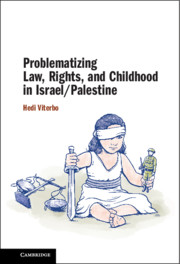Book contents
- Frontmatter
- Contents
- Acknowledgments
- Abbreviations
- 1 Conceptual and Theoretical Foundations
- 2 Casting the First Stone: The Israeli Legal System, Its Human Rights Critics, and Their Approaches to Young Palestinians
- 3 The Age of Governing: Young Age as a Means of Control
- 4 Boundary Governance: Amending Childhood and Separating Palestinians
- 5 Stolen Childhood: Voice, Loss, and Trauma in Human Rights Reports
- 6 Sights of Violence: Childhood in the Visual Battlefield
- 7 Infantilization and Militarism: Soldiers as Children, Children as Soldiers
- 8 Unsettling Children: Israeli Law and Settlers’ Childhood
- Index
4 - Boundary Governance: Amending Childhood and Separating Palestinians
Published online by Cambridge University Press: 05 August 2021
- Frontmatter
- Contents
- Acknowledgments
- Abbreviations
- 1 Conceptual and Theoretical Foundations
- 2 Casting the First Stone: The Israeli Legal System, Its Human Rights Critics, and Their Approaches to Young Palestinians
- 3 The Age of Governing: Young Age as a Means of Control
- 4 Boundary Governance: Amending Childhood and Separating Palestinians
- 5 Stolen Childhood: Voice, Loss, and Trauma in Human Rights Reports
- 6 Sights of Violence: Childhood in the Visual Battlefield
- 7 Infantilization and Militarism: Soldiers as Children, Children as Soldiers
- 8 Unsettling Children: Israeli Law and Settlers’ Childhood
- Index
Summary
Chapter 4 focuses on reforms in the first two decades of this century, which represented, for both Israel and the human rights community, fixing childhood’s spatial and age boundaries in line with legal standards. Key among them were the separation of incarcerated Palestinians under 18 from their elders; the establishment of the world’s only “military youth court”; raising the age of majority under military law; and assessment of the rehabilitation chances of Palestinian youth. Contrary to claims by Israeli officials and their human rights critics, this chapter reveals that some reforms have made no actual difference while others have served to fragment, monitor, and suppress Palestinians. Five broader issues exemplified by these reforms are discussed: the blind spots of human rights actors; the complicity of child law and children’s rights in the oppression of disempowered communities around the world; the growing convergence between military and nonmilitary Israeli law; the multiple forms of separation Israel imposes on Palestinians, which operate to divide and conquer them; and Israel’s attempts at confining Palestinian minds beyond the prison walls. Also examined are Palestinian acts of resistance: running study groups in prison, smuggling sperm of incarcerated men, and conducting readings and discussions in public protests.
Keywords
- Type
- Chapter
- Information
- Problematizing Law, Rights, and Childhood in Israel/Palestine , pp. 131 - 177Publisher: Cambridge University PressPrint publication year: 2021



